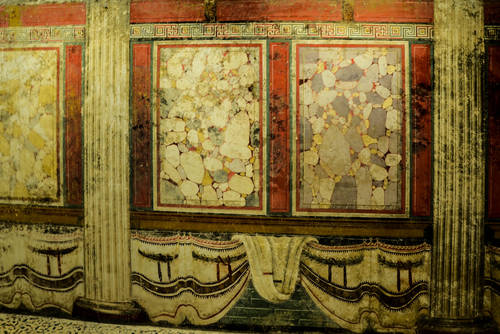Brescia is well known for its wealth of Roman remains due to the unique urban development of the town after the demise of the Roman Empire. The original nucleus of the settlement at the foot of the Cidneo hill became crown property under the Lombards in the 8th century and was largely occupied by a religious foundation. Medieval Brixia expanded to the west around watercourses that came in handy as Roman aqueducts and sewers went out of use.

Later the area became available again and a number of fine town houses were built on top of the Roman remains, with frequent use of spolia. The Roman street grid was largely respected: today’s Piazza del Foro is the same shape and size as the Roman forum. At its north end, the creatively reconstructed Capitolium (open Tues–Sun 9–5.30,10.30–7 in summer; entry fee) with its three cellae, one each for Juno, Jupiter and Minerva, its podium and monumental steps, dominates the scene. All around the piazza, the Renaissance houses are known to have Roman remains in their cellars; the archaeological trail at Palazzo Martinengo on the west side of the square is an excellent introduction to the complex archaeology.
Recently a couple of new venues have been opened to the public. In the forum itself, one cella of the Republican Temple is now accessible. It had been known for some time that the Capitolium (1st century AD) was not built on virgin soil. Two earlier buildings had been identified. The Republican Temple (1st century BC) had been levelled and backfilled to make way for the new structure willed by the emperor Vespasian. In the process Rome took the decision to stamp out any localism. The four cellae of the Republican Temple (three for the Capitoline Triad, one for a local deity) were reduced to three for the Capitoline Triad only. The local deity was completely obliterated: its name is now not even known. Its cella, however, is the one that has survived best and is now open to the public. The statue of the deity may be missing from its podium at the far end but the loss is largely compensated for by vivid painted decoration (illustrated above) with sumptuous dadoes imitating fanciful breccia marble underscored by elegant drapery. The floor is the finest mosaic, stark white with a black band, made of minute tesserae. Fluted columns are either trompe l’oeil or brick covered in painted stucco. Higher up on the wall, the grave and the drain belong to the Lombards. Further up a 17th-century building (Casa Pallaveri) obtrudes on the area. It is this stratification that has preserved the cella while at the same time making its display a technical challenge.
At the south end of the forum, part of the Roman Basilica (the legal and commercial heart of the town), over time incorporated in a later building, can now be visited (Mon–Fri 9–12). The entrance is in Piazza Labus (whose name celebrates a local 19th-century antiquarian and epigrapher). You can see immediately how much the street level has risen: over three metres. From the short bridge you can admire in situ the outer flooring made of thin slabs of imported marble arranged in a geometric design with contrasting blue-grey and white panels. Inside, in what is now the cellar, and was originally the ground floor, the flooring is the same pattern but the colour scheme is reversed. All around are the finds connected with the excavation of the area showing its development from the 5th century BC, with Attic pottery possibly obtained via Etruscan connections, through to its incorporation into the Roman forum; later, after the basilica lost its marble cladding and its roof, squatters moved in while earth and refuse accumulated. Towards the end of the 1st millennium AD, part of the basilica was a burial ground. It was the incorporation of the surviving elements of the south façade of the basilica into the so-called Palazzo d’Ercole around the 17th century that preserved it for us. In spite of its name, though, the new building was hardly a palace, with poky rooms and a dearth of decorative elements except for the painted terracotta ceilings.
Skipping the Roman theatre east of the Capitolium (it was hopelessly spoliated by the building of a Renaissance palace on top of it, now in part demolished), you can end your tour at Portici X Giornate 51. Here, at the back of an optician’s shop (Vigano’-Salmoiraghi), a substantial stretch of Roman urban road is accessible to the public. It is wide enough for two vehicles and the paving blocks are just enormous: you can’t fail to be impressed. All you are missing is the din of the populace and the screeching of the waggon wheels.
by Paola Pugsley, author of Blue Guide Crete and e-guides to Turkey.






